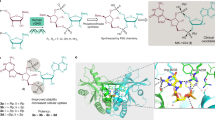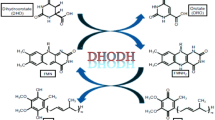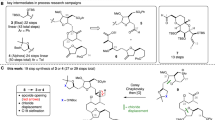Abstract
Tigilanol tiglate is a natural product diterpenoid in clinical trials for the treatment of a broad range of cancers. Its unprecedented protein kinase C isoform selectivity make it and its analogues exceptional leads for PKC-related clinical indications, which include human immunodeficiency virus and AIDS eradication, antigen-enhanced cancer immunotherapy, Alzheimer’s disease and multiple sclerosis. Currently, the only source of tigilanol tiglate is a rain forest tree, Fontainea picrosperma, whose limited number and restricted distribution (northeastern Australia) has prompted consideration of designed tree plantations to address supply needs. Here we report a practical laboratory synthesis of tigilanol tiglate that proceeds in 12 steps (12% overall yield, >80% average yield per step) and can be used to sustainably supply tigilanol tiglate and its analogues, the latter otherwise inaccessible from the natural source. The success of this synthesis is based on a unique strategy for the installation of an oxidation pattern common to many biologically active tiglianes, daphnanes and their analogues.

This is a preview of subscription content, access via your institution
Access options
Access Nature and 54 other Nature Portfolio journals
Get Nature+, our best-value online-access subscription
$29.99 / 30 days
cancel any time
Subscribe to this journal
Receive 12 print issues and online access
$259.00 per year
only $21.58 per issue
Buy this article
- Purchase on SpringerLink
- Instant access to full article PDF
Prices may be subject to local taxes which are calculated during checkout




Similar content being viewed by others
Data availability
The data supporting the findings of this study are available within the article and its Supplementary Information. The X-ray structure of phorbol-13-acetate bound to the PKC-C1 domain was obtained from the structure reported by Hurley (Protein Data Bank: 1PTR).
References
Newton, A. C. & Brognard, J. Reversing the paradigm: protein kinase C as a tumor suppressor. Trends Pharmacol. Sci. 38, 438–447 (2017).
Kim, J. T. et al. Latency reversal plus natural killer cells diminish HIV reservoir in vivo. Nat. Commun. 13, 121 (2022).
Ramakrishna, S. et al. Modulation of target antigen density improves CAR T-cell functionality and persistence. Clin. Cancer Res. 25, 5329–5341 (2019).
Hardman, C. et al. Synthesis and evaluation of designed PKC modulators for enhanced cancer immunotherapy. Nat. Commun. 11, 1–11 (2020).
Marro, B. S. et al. Discovery of small molecules for the reversal of T-cell exhaustion. Cell Rep. 29, 3293–3302 (2019).
Sun, M.-K., Hongpaisan, J., Lim, C. S. & Alkon, D. L. Bryostatin-1 restores hippocampal synapses and spatial learning and memory in adult fragile X mice. J. Pharmacol. Exp. Ther. 349, 393–401 (2014).
Kornberg, M. D. et al. Bryostatin-1 alleviates experimental multiple sclerosis. Proc. Natl Acad. Sci. USA 115, 2186–2191 (2018).
Gutiérrez, C. et al. Bryostatin-1 for latent virus reactivation in HIV-infected patients on antiretroviral therapy. AIDS 30, 1385–1392 (2016).
Farlow, M. R. et al. A randomized, double-blind, placebo-controlled, phase II study assessing safety, tolerability, and efficacy of bryostatin in the treatment of moderately severe to severe Alzheimer’s disease. J. Alzheimers Dis. 67, 555–570 (2019).
Panizza, B. J. et al. Phase I dose-escalation study to determine the safety, tolerability, preliminary efficacy and pharmacokinetics of an intratumoral injection of tigilanol tiglate (EBC-46). EBioMedicine 50, 433–441 (2019).
Cullen, J. K. et al. Activation of PKC supports the anticancer activity of tigilanol tiglate and related epoxytiglianes. Sci Rep. 11, 1–14 (2021).
Miller, J. et al. Dose characterization of the investigational anticancer drug tigilanol tiglate (EBC-46) in the local treatment of canine mast cell tumors. Front. Vet. Sci. 6, 1–10 (2019).
Moses, R. L. et al. Novel epoxy-tiglianes stimulate skin keratinocyte wound healing responses and re-epithelialization via protein kinase C activation. Biochem. Pharmacol. 178, 114048 (2020).
Boyle, G. M. et al. Intra-lesional injection of the novel PKC activator EBC-46 rapidly ablates tumors in mouse models. PLoS ONE 9, 1–12 (2014).
FDA Approves First Intratumoral Injection to Treat Non-Metastatic Mast Cell Tumors in Dogs https://www.fda.gov/news-events/press-announcements/fda-approves-first-intratumoral-injection-treat-non-metastatic-mast-cell-tumors-dogs (2020).
De Ridder, T. R. et al. Randomized controlled clinical study evaluating the efficacy and safety of intratumoral treatment of canine mast cell tumors with tigilanol tiglate (EBC-46). J. Vet. Intern. Med. 35, 415–429 (2020).
Lamont, R. W., Conroy, G. C., Reddell, P. & Ogbourne, S. M. Population genetic analysis of a medicinally significant Australian rainforest tree, Fontainea Picrosperma C.T. White (Euphorbiaceae): biogeographic patterns and implications for species domestication and plantation establishment. BMC Plant Biol. 16, 1–12 (2016).
Grant, E. L. et al. Floral attraction and flower visitors of a subcanopy, tropical rainforest tree, Fontainea Picrosperma. Ecol. Evol. 11, 10468–10482 (2021).
Paul, I., Reddell, W., Gordon, V. A. Tiglien-3-one derivatives. US Patent 9770431B2 (2017).
Grant, E. Reproductive Biology, Flowering and Genetics of Fontainea picrosperma (Euphorbiaceae). PhD thesis, Univ. Sunshine Coast (2020).
Wender, P. A., Quiroz, R. V. & Stevens, M. C. Function through synthesis-informed design. Acc. Chem. Res. 48, 752–760 (2015).
Wang, Z. & Hui, C. Contemporary advancements in the semi-synthesis of bioactive terpenoids and steroids. Org. Biomol. Chem. 19, 3791–3812 (2021).
Wender, P. A., Verma, V. A., Paxton, T. J. & Pillow, T. H. Function-oriented synthesis, step economy, and drug design. Acc. Chem. Res. 41, 40–49 (2008).
Kim, K. E., Kim, A. N., McCormick, C. J. & Stoltz, B. M. Late-stage diversification: a motivating force in organic synthesis. J. Am. Chem. Soc. 143, 16890–16901 (2021).
Newman, D. J. & Cragg, G. M. Natural products as sources of new drugs over the nearly four decades from 01/1981 to 09/2019. J. Nat. Prod. 83, 770–803 (2020).
Liu, W. C., Gong, T. & Zhu, P. Advances in exploring alternative Taxol sources. RSC Adv. 6, 48800–48809 (2016).
Wender, P. A., Rice, K. D. & Schnute, M. E. The first formal asymmetric synthesis of phorbol. J. Am. Chem. Soc. 119, 7897–7898 (1997).
Lee, K. & Cha, J. K. Formal synthesis of (+)-phorbol. J. Am. Chem. Soc. 123, 5590–5591 (2001).
Kawamura, S., Chu, H., Felding, J. & Baran, P. S. Nineteen-step total synthesis of (+)-phorbol. Nature 532, 90–93 (2016).
Wang, H. B., Wang, X. Y., Liu, L. P., Qin, G. W. & Kang, T. G. Tigliane diterpenoids from the Euphorbiaceae and Thymelaeaceae families. Chem. Rev. 115, 2975–3011 (2015).
Ahmed, W. A. & Salimon, J. Phorbol ester as toxic constituents of tropical Jatropha curcas seed oil. Eur. J. Sci. Res. 31, 429–436 (2009).
Pagani, A., Gaeta, S., Savchenko, A. I., Williams, C. M. & Appendino, G. An improved preparation of phorbol from croton oil. Beilstein J. Org. Chem. 13, 1361–1367 (2017).
Zimmermann, T., Franzyk, H. & Christensen, S. B. Phorbol rearrangements. J. Nat. Prod. 81, 2134–2137 (2018).
Hou, Z., Yao, G. & Song, S. Daphnane-type diterpenes from genus Daphne and their anti-tumor activity. Chin. Herbal Medicines 13, 145–156 (2021).
Zhang, G., Kazanietz, M. G., Blumberg, P. M. & Hurley, J. H. Crystal structure of the Cys2 activator-binding domain of protein kinase Cδ in complex with phorbol ester. Cell 81, 917–924 (1995).
Wender, P. A., Donneley, A. C., Loy, B. A., Near, K. E., Staveness, D. in Natural Products in Medicinal Chemistry (ed. Hanessian, S.) 475–544 (Wiley-VCH, 2014).
Schmidt, R. & Hecker, E. Autoxidation of phorbol esters under normal storage conditions. Cancer Res. 35, 1375–1377 (1994).
Amin, H. I. M. et al. The allylic oxidation of tigliane esters. Fitoterapia 148, 104802 (2021).
Ghogare, A. A. & Greer, A. Using singlet oxygen to synthesize natural products and drugs. Chem. Rev. 116, 9994–10034 (2016).
Sagadevan, A., Hwang, K. C. & Su, M.-D. Singlet oxygen-mediated selective C–H bond hydroperoxidation of ethereal hydrocarbons. Nat. Commun. 8, 1812 (2017).
Lévesque, F. & Seeberger, P. H. Highly efficient continuous flow reactions using singlet oxygen as a ‘green’ reagent. Org. Lett. 13, 5008–5011 (2011).
Volchkov, I. & Lee, D. Recent developments of direct rhenium-catalyzed [1,3]-transpositions of allylic alcohols and their silyl ethers. Chem. Soc. Rev. 43, 4384–4394 (2014).
Morrill, C., Beutner, G. L. & Grubbs, R. H. Rhenium-catalyzed 1,3-isomerization of allylic alcohols: scope and chirality transfer. J. Org. Chem. 71, 7813–7825 (2006).
Ferrier, R. J. & Hall, D. W. One-step synthesis of glycosidic spiroketals from 2,3-epoxybutyl glycoside derivatives. J. Chem. Soc. Perkin Trans. 1992, 3029–3034 (1992).
Wender, P. A. et al. Gateway synthesis of daphnane congeners and their protein kinase C affinities and cell-growth activities. Nat. Chem. 3, 615–619 (2011).
Boudreault, P. L., Mattler, J. K. & Wender, P. A. Studies on the regio- and diastereo-selective epoxidation of daphnanes and tiglianes. Tetrahedron Lett. 56, 3423–3427 (2015).
Johnson, T. C. et al. Synthesis of Eupalinilide E, a promoter of human hematopoietic stem and progenitor cell expansion. J. Am. Chem. Soc. 138, 6068–6073 (2016).
Benner, N. L. et al. Functional DNA delivery enabled by lipid-modified charge-altering releasable transporters (CARTs). Biomacromolecules 19, 2812–2824 (2018).
Acknowledgements
This work was supported by grants from the National Institutes of Health (NIH) (CA31845 and AI124743; Z.O.G., D.J.F., O.D.M., Q.H.L.-N and E.N.). O.D.M. thanks the Molecular Pharmacology Training Program for support. We also thank H. Rahn for thoughtful discussions and assistance in the purification. Confocal images were acquired at the Stanford Neuroscience Microscopy Services. High-resolution mass spectrometric data were acquired at the Vincent Coates Foundation Mass Spectrometry Laboratory, supported in part by NIH P30 CA124435 utilizing the Stanford Cancer Institute Proteomics/Mass Spectrometry Shared Resource. Computational efforts were performed on the Sherlock cluster (Stanford University).
Author information
Authors and Affiliations
Contributions
Z.O.G., D.J.F., O.D.M., Q.H.L.-N. and E.N. prepared the compounds; D.J.F. performed the binding and translocation assays; E.N. performed the computational studies; P.A.W. and all the authors provided guidance on the design and analysis of experiments and wrote the manuscript.
Corresponding author
Ethics declarations
Competing interests
A provisional patent application (docket number S21-064) has been filed by Stanford University, on behalf of Paul A. Wender (principal investigator), Zachary O. Gentry, David J. Fanelli, Quang H. Luu-Nguyen, Owen D. McAteer and Edward Njoo, that covers a method to synthesize tigilanol tiglate (EBC-46) and related compounds from readily available starting materials.
Peer review
Peer review information
Nature Chemistry thanks Mireille Bilonda and the other, anonymous, reviewer(s) for their contribution to the peer review of this work.
Additional information
Publisher’s note Springer Nature remains neutral with regard to jurisdictional claims in published maps and institutional affiliations.
Supplementary information
Supplementary Information
Materials and Methods, Supplementary discussion, Figs. 1–11, Tables 1–4 and additional references 49–56.
Rights and permissions
Springer Nature or its licensor holds exclusive rights to this article under a publishing agreement with the author(s) or other rightsholder(s); author self-archiving of the accepted manuscript version of this article is solely governed by the terms of such publishing agreement and applicable law.
About this article
Cite this article
Wender, P.A., Gentry, Z.O., Fanelli, D.J. et al. Practical synthesis of the therapeutic leads tigilanol tiglate and its analogues. Nat. Chem. 14, 1421–1426 (2022). https://doi.org/10.1038/s41557-022-01048-2
Received:
Accepted:
Published:
Issue Date:
DOI: https://doi.org/10.1038/s41557-022-01048-2
This article is cited by
-
Tigliane and daphnane diterpenoids from Thymelaeaceae family: chemistry, biological activity, and potential in drug discovery
Journal of Natural Medicines (2023)



